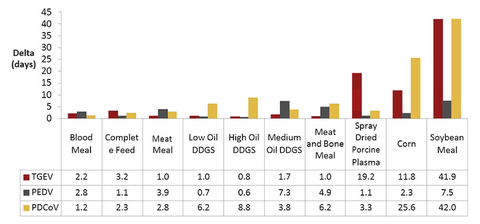Quick facts
- There are three known coronaviruses that have devastating impacts on the swine industry.
- The viruses can be spread through equipment, people, other objects and feed.
- Contaminated soybean meal has the greatest potential risk for transmitting swine coronaviruses.
- University of Minnesota research shows promising ways to reduce virus survival and risk in soybean meal.
Contaminated soybean meal has the greatest potential risk for transmitting swine coronaviruses.
Developing and using biosecurity programs at feed mills can reduce the risk of coronavirus in feed and feed ingredients. Talk to your feed supplier about the risk and potential ways to lessen or control virus transmission through feed delivered to your farm. This is especially important if you obtain ingredients and feed from places where coronaviruses are more common.
University of Minnesota research shows potential benefits of heat processing, radiation exposure (irradiation), and organic acids to reduce virus survival and risk when applied to soybean meal.
Delta values represent the length of time necessary to reduce the amount of virus by 90 percent. Porcine delta coronavirus (PDCoV) generally has a greater delta value than other coronaviruses for several feed ingredients. Thus, control methods for PDCoV should also reduce the survival of porcine epidemic diarrhea virus (PEDV).
Swine coronaviruses
The three known porcine coronaviruses include:
- Transmissible gastroenteritis virus (TGEV)
- Porcine delta coronavirus (PDCoV)
- Porcine epidemic diarrhea virus (PEDV)
These coronaviruses have devastating effects on the pork industry and cause
- Severe diarrhea in young pigs
- Increased mortality
- Subsequent reductions in growth performance
- Increased cost to producers
These viruses pass via feces and can be spread by contaminated equipment, people, and other objects. After the 2013 outbreaks of PEDV in the United States, proof suggested contaminated feed and feed ingredients can also spread PEDV.
University of Minnesota research shows that additives that make feed acidic can reduce virus survival and risk. These additives inactivate PEDV and PDCoV in complete feed.
Another University of Minnesota study shows the survival rate of PEDV and PDCoV in complete feed and feed ingredients. To better understand virus transmission through feed, University of Minnesota researchers measured the survival times of PEDV, PDCoV and TGEV in feed.
Testing corona virus survival in feed and feed ingredients
University of Minnesota researchers took samples of common feed ingredients and a Phase 2 nursery diet. These samples tested negative for all coronaviruses. In the laboratory, researchers contaminated each sample with PEDV, PDCoV, or TGEV. The samples were mixed and stored at room temperature for 56 days.
Throughout this time period, viruses from each sample were put into cells and observed for viral infection. With this information researchers used a predictive model to produce delta values. Delta values represent the length of time needed to reduce the amount of virus by 90 percent. Researchers then used these values to compare survival of corona viruses in the feed and feed ingredients.
Survival time of PDCoV (delta: 41.9 days) and TGEV (delta: 42.0 days) was greatest in soybean meal (table 1). PEDV also had high survival in soybean meal, but not as high as reported in previous research. Lower PEDV survival in this study may be due to a smaller starting amount of virus.
- Delta values were high for PDCoV (25.6 days) and TGEV (11.8 days) in corn.
- TEGV survived longer (19.2 days) in spray dried porcine plasma compared to corn but had lower PEDV and PDCoV survival.
When comparing the survival of the three viruses among ingredients, PDCoV had higher delta values than TGEV for
- High oil distiller’s dried grains with solubles (DDGS)
- Low oil DDGS
- Meat and bone meal
- Corn
Longer survival times in these ingredients suggest a greater risk of transmission.
University of Minnesota researchers also looked at how the following nutrient factors influenced virus survival.
- Crude fat
- Moisture
- Crude protein
- Ash
- Fiber
Higher moisture levels in feed ingredients tended to have greater survival of PDCoV and TGEV compared with PEDV. This association is only considered moderately related.
Cottingim, K. M., Trudeau, M. P., Verma, H., Sampedro, F., Urriola, P. E., Shurson, G. C., & Goyal, S. M. (2015). Effect of additives on the survival of porcine delta coronavirus and porcine epidemic diarrhea virus in swine feed. In Leman Conference. St. Paul, MN.
Dee, S., Neill, C., Clement, T., Singrey, A., Christopher-Hennings, J., & Nelson, E. (2015). An evaluation of porcine epidemic diarrhea virus survival in individual feed ingredients in the presence or absence of a liquid antimicrobial. Porcine Health Management, 1–10.
Trudeau, M., Cottingim, K., Verma, H., Sampedro, F., Urriola, P., Shurson, G., & Goyal, S. (2015). Survival of Porcine Epidemic Diarrhea Virus (PEDV) and Porcine Delta Corona Virus (PDCV) in Complete Feed and Feed Ingredients. In Leman Conference. St. Paul, MN.
Trudeau, M. P., Verma, H., Sampedro, F., Urriola, P. E., Shurson, G. C., & Goyal, S. M. (2015). Survival of porcine epidemic diarrhea virus (PEDV) in swine complete feed with various processing techniques. In Minnesota Nutrition Conference. Prior Lake, MN.
Reviewed in 2019


